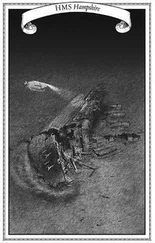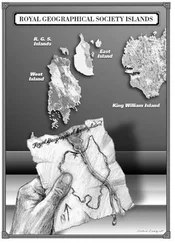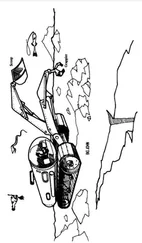The news of Kitty Mannock's disappearance flashed around the world a few hours after she was reported overdue for her fuel stop at Niamey. A large-scale search and rescue operation was impossible. It was to be a meager effort. The region of the desert where Kitty went missing was mostly uninhabited and rarely seen by humans. There were no aircraft within a thousand miles. An army of men and equipment simply did not exist in the desert in 1931.
A search was launched the following mourning by a small mechanized unit of the French Foreign Legion stationed in what was then the French Sudan at the oasis of Takaldebey. Assuming she came down somewhere along the TransSahara motor track, they worked north, while a few men and two autos from a French trading company at Tessalit worked south.
The two search parties met on the motor track two days later without sighting wreckage or flares in the night. They fanned 20 miles on either side of the track and tried again. After ten days of finding no sign of the lost pilot, the commander of the Legion detachment was not optimistic. No man or woman could have lived that long without food and water in the sun-scorched desert, he reported. By now Kitty would have surely died of exposure.
Memorial services were conducted for one of aviation's most beloved fliers in every major city. Considered one of the three greatest women pilots along with Amelia Earhart and Amy Johnson, Kitty was mourned by a world that had thrilled to her exploits. A lovely woman with deep blue eyes and black flowing hair that fell to her waist when released, she was the daughter of wealthy sheep ranchers outside of Canberra, Australia. After graduating from an advanced girls school, she had taken flying lessons. Surprisingly, her mother and father supported her urge to fly and bought her a second-hand Avro Avian biplane with an open cockpit and 80-horsepower Cirrus engine.
Six months later, against all pleas to stay home, she had island hopped across the Pacific to Hawaii and landed to the cheers of a huge crowd who had waited anxiously for her arrival. With sunburned face and oil-stained khaki shirt and shorts, Kitty wearily smiled and waved, stunned at the unexpected reception. She went on to win the hearts of millions and became a household word for her record-breaking flights across the oceans and continents.
This was to have been her last long-distance attempt before marrying a girlhood sweetheart who was a neighboring rancher in Australia. After mastering the air, the luster had strangely worn off and she was looking forward to settling down and raising a family. She had also found what so many others had experienced in the pioneering days of aviation; there was glory but few paying jobs for pilots.
She had almost canceled the flight, but stubbornly persisted in seeing it through. And now the aviation world waited for word of her rescue with a hope that faded as the days wore on.
Kitty remained unconscious until dawn the next morning. The sun was beginning to scorch the desert when she struggled from the depths of blackness and focused her eyes on the splintered stub of the propeller. Her vision came blurred. She tried to shake her head to clear the fog and gasped from the pain that stabbed her head. Gently, she touched her forehead. The skin was unbroken but a large knot rose along the hairline. She checked for other injuries and discovered the cracked ankle that had swollen inside her flying boot and the twisted knee.
She unbuckled her safety harness, pushed open the cabin door, and carefully climbed from the plane. Limping a few paces, Kitty sank slowly onto the sand and took stock.
Fortunately, there had been no fire, but the faithful Fairchild would never fly again. The engine, three of its cylinders cracked on impact with the ravine slope, was bent upward on a crazy angle. The wings were amazingly intact as was the airframe, but the undercarriage had been mashed flat with the wheels bent outward.
So much for making repairs and continuing on. Her next problem was to determine her location. She had no idea where she had come down. She judged she had fallen in what they called in Australia a billabong, a dry streambed that is filled seasonally. Only the sand in this one probably hadn't seen water in a hundred years. The sandstorm had died, but the walls of the small gorge where she lay were a good 20 feet high, and she could not see the landscape beyond. Better she didn't. It was colorless, desolate, and ugly beyond description.
She felt a sudden thirst, and the thought of water reminded her of her canteen. She hopped back to the cabin door on one leg, leaned in, and pulled it from under the seat. Its capacity was only half a gallon, and it was less than two thirds full. Kitty realized she'd be lucky if it lasted her more than two or three days and dared not take more than a few sips at a time.
She decided she had to make an attempt at reaching a village or the motor track. It was suicide to stay near the ship. Unless an aircraft flew directly overhead, the Fairchild could not be seen. Still shaky, she stretched out under the shade of the plane and resigned herself to her predicament.
Kitty was soon to discover the incredible contrast of temperatures in the Sahara. During the day, the air climbed to 120 degrees F (49 degrees C) and dropped to 39 degrees F (4 degrees C) at night. The agonizing cold of the night was as torturous as the daytime heat. After suffering twelve hours of burning sun, she scrapped out a burrow in the sand and crawled into it. Then she huddled in a ball, shivering and sleeping fitfully until dawn.
In the early morning of the second day, before the sun began to beat down, she felt strong enough to launch her preparations to abandon the airplane. She fashioned herself a crutch from a wing strut and made a crude umbrella from the wing fabric. Using a small set of tools, she removed the compass from the instrument panel. Despite her injuries, Kitty was determined to strike out for the motor track. She felt she had no alternative.
Feeling better now for having a plan, Kitty took her logbook and began writing the first page of what was to be the account of her perseverance and heroic attempt to survive under the worst conditions imaginable. She opened the entry by describing the crash and sketching her intended trek south down the billabong until she found an easy climb to the rim. Once in the open, she planned to head due east until she picked up the motor track or ran across a tribe of wandering nomads. Then she tore out the page and attached it to the instrument panel so that rescuers could follow her trail in the unlikely event the plane was discovered first.
The heat was rapidly becoming unbearable. Her situation was made even worse by the walls of the gully that reflected and magnified the sun's rays like an open crematorium. She found it difficult to breathe and had to fight off a terrible urge to drink her precious water in large swallows.
One last act before she set out. She unlaced the boot on her fractured ankle and tenderly removed it. The pain forced a soft groan from her lips, and she let it ease before binding the ankle in her silk flying scarf Then with the compass and canteen attached to her belt, the umbrella held high, and the crutch snug under one arm, Kitty set out under the onslaught of the Sahara sun, limping gamely across the sand of the ancient riverbed.
The search for Kitty Mannock continued off and on over the years, but neither she nor her plane were ever sighted. No clue turned up, no camel caravan came across a skeleton in the desert that was dressed in the old-fashioned flying togs of the thirties, no wandering nomad stumbled on the wrecked airplane. Kitty's total disappearance became one of the great mysteries of aviation.
Rumors of Kitty's ultimate fate grew and spread over the decades. Some claimed that she had survived but was suffering from amnesia and living under another name in South America, and many thought she was captured and enslaved by a tribe of Tuaregs. Only Amelia Earhart's flight into the unknown caused more speculation.
Читать дальше












